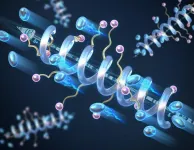(Press-News.org) In September 2023, a megatsunami in remote eastern Greenland sent seismic waves around the world, piquing the interest of the global research community.
The event created a week-long oscillating wave in Dickson Fjord, according to a new report in The Seismic Record.
Angela Carrillo-Ponce of GFZ German Research Centre for Geoscience and her colleagues identified two distinct signals in the seismic data from the event: one high-energy signal caused by the massive rockslide that generated the tsunami, and one very long-period (VLP) signal that lasted over a week.
Their analysis of the VLP signal—which was detected as far as 5000 kilometers away—suggests that the landslide and resulting tsunami created a seiche, or a standing wave that oscillates in a body of water. In this case, the seiche was churning for days between the shores of Dickson Fjord.
“The fact that the signal of a rockslide-triggered sloshing wave in a remote area of Greenland can be observed worldwide and for over a week is exciting, and as seismologists this signal was what mostly caught our attention,” said Carrillo-Ponce.
“The analysis of the seismic signal can give us some answers regarding the processes involved and may even lead to improved monitoring of similar events in the future. If we had not studied this event seismically, then we would not have known about the seiche produced in the fjord system,” she added.
The findings will help researchers as they study the impacts of landslides in Greenland and similar regions around the world where global warming and the loss of permafrost are making rocky slopes and glaciers increasingly unstable.
In western Greenland, recent tsunamis have had devastating consequences, such as the 2017 Karrat Fjord event where an avalanche caused a tsunami that flooded the village of Nuugaatsiaq and killed four people. Megatsunamis over 100 meters high off the east coast of Greenland have also reached Europe.
The 16 September 2023 megatsunami took place in Dickson Fjord in a remote part of East Greenland, and was first noted in social media posts and in a report of waves hitting a military installation on Ella Island.
Carrillo-Ponce and colleagues studied both seismic signals and satellite imagery from the area to precisely locate and reconstruct the series of events.
Their analysis of an initial high-energy seismic signal, combined with satellite images of a missing rock patch along a cliff along Dickson Fjord, allowed them to trace the direction of the landslide as it picked up glacier ice and became a mixed rock-ice avalanche before it reached the water. The resulting megatsunami run-up was more than 200 meters near the water entry point and an average of 60 meters along a 10-kilometer stretch of the fjord.
“While we were able to obtain information on the direction and magnitude of the force exerted by the landslide, we do not have data to investigate the original cause of the landslide,” Carrillo-Ponce said.
The strength, radiation pattern and duration of the later seismic VLP signal best fit a scenario where the tsunami created a long-lasting seiche in the fjord, the researchers found.
VLP signals have been observed previously in Greenland, but they are usually associated with iceberg collapse due to glacial earthquakes. “In our case we observed a VLP signal too, but the main difference is the long duration,” Carrillo-Ponce explained. “It is quite impressive to see that we could use good-quality data from stations located as far as Germany, Alaska and North America, and that those records were strong enough for at least one week.”
The researchers say their approach might prove useful in studying similar past events, and their possible link to climate and environmental change.
“We have compared our results with remote sensing data to validate our solutions, and our study shows that the force produced by the signals is well resolved,” Carrillo-Ponce said. “Therefore it becomes a useful analysis as seismic signals contain information on the type of source generating the signal and how the energy is radiated.”
END
Greenland megatsunami led to week-long oscillating fjord wave
2024-08-09
ELSE PRESS RELEASES FROM THIS DATE:
Machine learning approach helps researchers design better gene-delivery vehicles for gene therapy
2024-08-08
Gene therapy could potentially cure genetic diseases but it remains a challenge to package and deliver new genes to specific cells safely and effectively. Existing methods of engineering one of the most commonly used gene-delivery vehicles, adeno-associated viruses (AAV), are often slow and inefficient.
Now, researchers at the Broad Institute of MIT and Harvard have developed a machine-learning approach that promises to speed up AAV engineering for gene therapy. The tool helps researchers engineer the protein shells of AAVs, called capsids, to have multiple desirable ...
Bacteria encode hidden genes outside their genome—do we?
2024-08-08
NEW YORK, NY (Aug. 8, 2024) -- Since the genetic code was first deciphered in the 1960s, our genes seemed like an open book. By reading and decoding our chromosomes as linear strings of letters, like sentences in a novel, we can identify the genes in our genome and learn why changes in a gene’s code affect health.
This linear rule of life was thought to govern all forms of life—from humans down to bacteria.
But a new study by Columbia researchers shows that bacteria break that rule and can create free-floating and ephemeral genes, raising the possibility that similar genes exist outside ...
Assistant professor's $1.1M NASA grant to develop computational tool aiding hypersonic vehicle design
2024-08-08
STARKVILLE, Miss.—NASA is awarding a Mississippi State University assistant professor a $1.13 million grant to develop a new simulation tool to aid the design of hypersonic vehicles used in space exploration.
Vilas Shinde of MSU’s Department of Aerospace Engineering won the grant to develop a new flow stability and transition analysis tool, which will aid researchers and aircraft designers in understanding and predicting changes associated with the boundary layer—air flow in the vicinity of an aircraft’s ...
Houston Methodist study shows new, more precise way to deliver medicine to the brain
2024-08-08
Houston Methodist researchers have discovered a more accurate and timely way to deliver life-saving drug therapies to the brain, laying the groundwork for more effective treatment of brain tumors and other neurological diseases.
In a study published this month in Communications Biology, an open access journal from Nature Portfolio, investigators used an electric field to infuse medicine from a reservoir outside the brain to specific targets inside the brain. This adds a new dimension to the 30-year-old process of injecting therapeutics into the brain through ...
A ‘thank you’ goes a long way in family relationships
2024-08-08
URBANA, Ill. – You’ve probably heard that cultivating gratitude can boost your happiness. But in marriage and families, it’s not just about being more grateful for your loved ones — it’s also important to feel appreciated by them. Researchers at the University of Illinois Urbana-Champaign have previously explored the positive impact of perceived gratitude from romantic partners for couples’ relationship quality. In a new study, they show the benefits of perceived gratitude ...
How a legal loophole allows unsafe ingredients in US foods
2024-08-08
The Food and Drug Administration (FDA) is tasked with overseeing the safety of the U.S. food supply, setting requirements for nutrition labeling, working with companies on food recalls, and responding to outbreaks of foodborne illness. But when it comes to additives already in our food and the safety of certain ingredients, FDA has taken a hand-off approach, according to a new article in the American Journal of Public Health.
The current FDA process allows the food industry to regulate itself when it comes to thousands of added ...
USC researchers develop AI model that predicts the accuracy of protein–DNA binding
2024-08-08
A new artificial intelligence model developed by USC researchers and published in Nature Methods can predict how different proteins may bind to DNA with accuracy across different types of protein, a technological advance that promises to reduce the time required to develop new drugs and other medical treatments.
The tool, called Deep Predictor of Binding Specificity (DeepPBS), is a geometric deep learning model designed to predict protein–DNA binding specificity from protein–DNA complex structures. DeepPBS ...
Increasing solid-state electrolyte conductivity and stability using helical structure
2024-08-08
Solid-state electrolytes have been explored for decades for use in energy storage systems and in the pursuit of solid-state batteries. These materials are safer alternatives to the traditional liquid electrolyte—a solution that allows ions to move within the cell—used in batteries today. However, new concepts are needed to push the performance of current solid polymer electrolytes to be viable for next generation materials.
Materials science and engineering researchers at the University of Illinois Urbana-Champaign have explored the role of helical secondary structure on the conductivity of solid-state peptide polymer ...
The threat of mpox has returned, but public knowledge about it has declined
2024-08-08
PHILADELPHIA – It has been two years since the World Health Organization declared a global health emergency over an outbreak of mpox, a disease endemic to Africa that had spread to scores of countries. Now, in the summer of 2024, a deadlier version of the infectious disease has spread from the Democratic Republic of Congo to other African nations, the strain that originally hit the United States has shown signs of a resurgence, and this week the Centers for Disease Control and Prevention (CDC) issued a new alert on mpox to health care providers.
But while the American public quickly learned about the disease during the summer of 2022, as ...
How does traumatic brain injury progress to Alzheimer’s disease?
2024-08-08
RIVERSIDE, Calif. -- A traumatic brain injury, or TBI, is caused by a contusion to the head that may result in injury to the brain. This type of injury combined with the inherited genetic risk factors can result in the accelerated development of Alzheimer’s disease and related dementia, or ADRD. TBIs range from mild to severe, with the majority being mild. They are especially common in adolescents engaging in contact sports and in the elderly who tend to fall with greater frequency as they age. Regardless of the source, TBI and how it progresses to ADRD is an understudied area of research.
A $3.5 million grant to the University of California, ...


